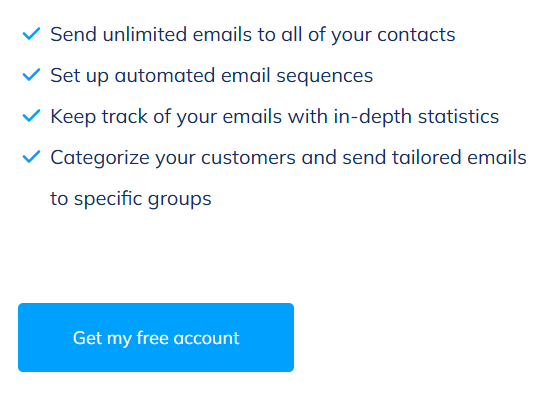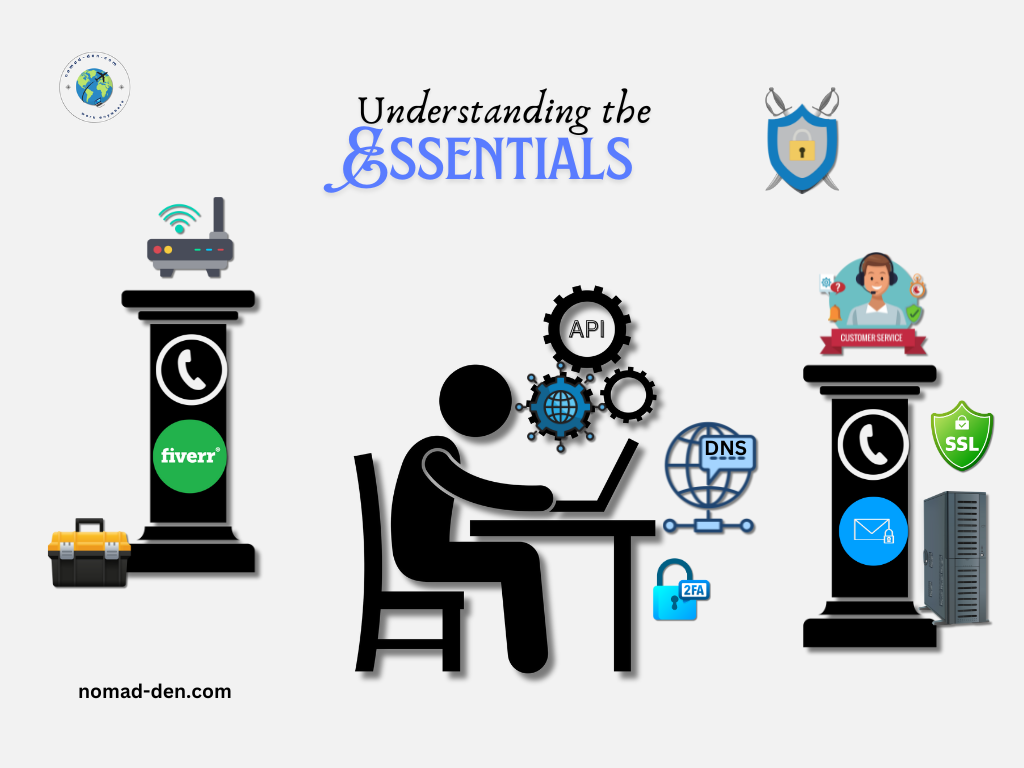
Affiliate Disclosure: This post contains affiliate links. If you click on these links and make a purchase, I may earn a commission at no additional cost to you. I only recommend products or services I genuinely believe in and that I believe will add value to my readers. Thank you for your support!
Starting an online business comes with many challenges that everyone faces differently. Some of the most common challenges we all face are an avalanche of acronyms, like DNS, DKIM, and API, etc., that can seem intimidating at first. Within this post, we’re going to cover some of the foundational hurdles that everyone inevitably faces while building their systems.
Depending on the tools you invest in during this construction phase of your business, you’ll likely encounter some of these obstacles. You might even hit a brick wall, depending on your experience and technical proficiency. Our goal is to equip you with practical tools and insights that will help you navigate these technical trials with confidence, paving the way for a successful online business.
Domain and Hosting Setup
Purchasing a domain and web hosting service is one of the easiest and most exciting steps when starting your online business. It’s a simple process that unlocks the gateway to getting your website up and running.
However, they don’t come without their challenges when it comes to getting your website set up. Technical aspects—such as DNS setup, SSL installation, and ensuring your website performs efficiently—can vary depending on the provider.
Start with a Reliable Hosting Provider
- Why it matters: A solid hosting provider often minimizes the number of technical issues you’ll face. Reliable customer support and easy-to-use DNS management tools are essential for resolving problems quickly.
- How to Approach: When you run into issues, make sure you’re familiar with your hosting provider’s support options. Keep guides and tutorials on hand for tasks like DNS management or SSL certificate setup.
To get started, you’ll need both a domain and web hosting. If you’re unsure which hosting provider is right for you, you can learn more about domain and web hosting options here before diving into the rest of your setup.
Once you’ve secured a reliable host, you’ll want to understand a few key concepts that affect how your website runs behind the scenes.
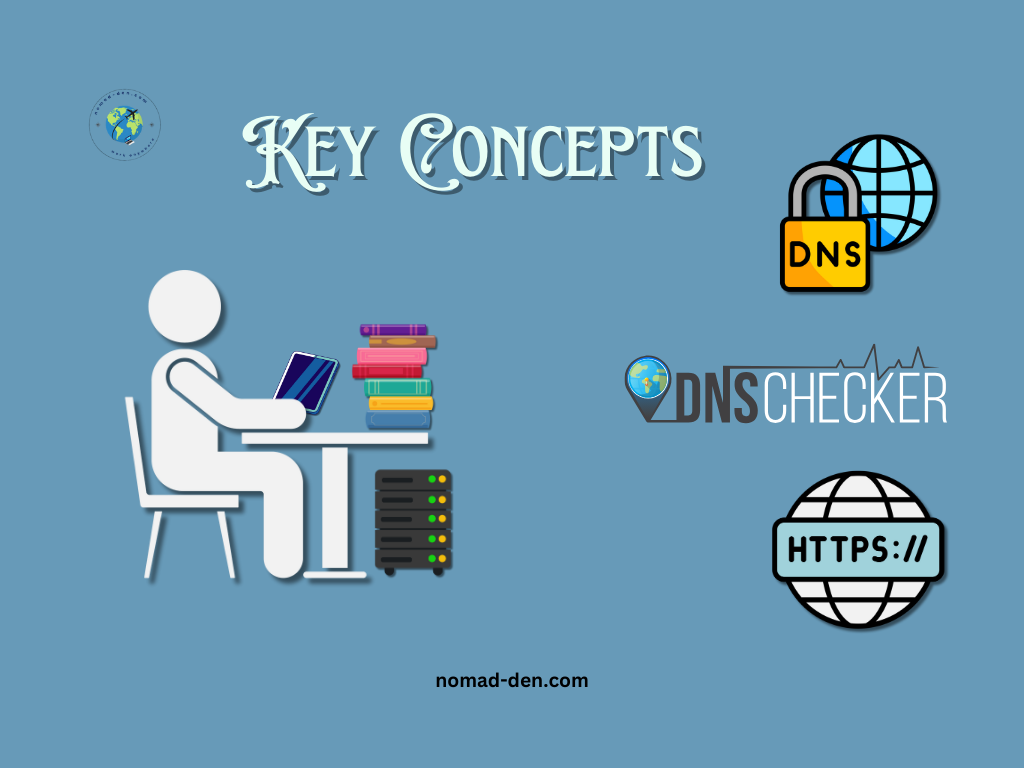
Familiarize Yourself with Key Concepts
- DNS (Domain Name System): Understanding what is a DNS server helps make domain issues less mysterious. If your website isn’t loading, it’s often related to DNS misconfiguration. DNS records are often long, complicated alphanumeric codes that are best copied rather than typed out.
- DNSChecker.org: If you’ve seen errors like DNS not responding, learn how to check propagation or use a tool like DNSChecker.org. It is a free tool that verifies whether your changes have been applied globally, ensuring your website’s accessibility.
- HTTPs (Hypertext Transfer Protocol Secure): The secure version of HTTP. It ensures that data transferred between your site and visitors is encrypted. Search engines also favor HTTPs-enabled sites, making it a ranking factor in SEO.
For more explanations of some of these terms and more, explore our Glossary for the full definitions.
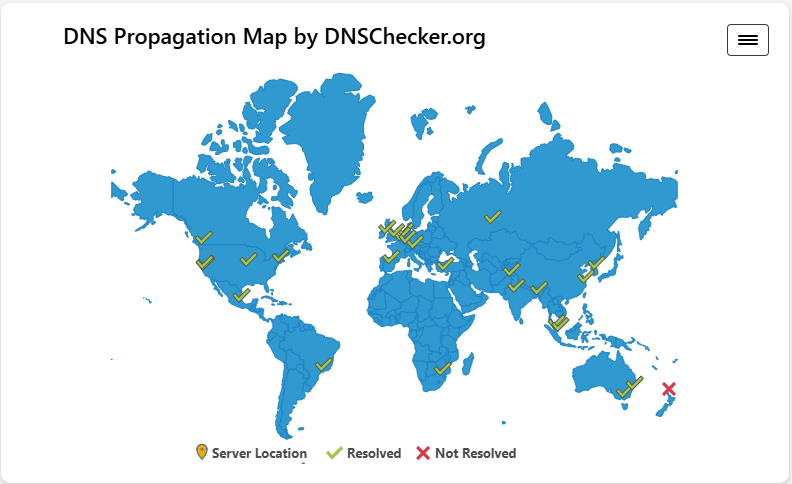
Website Optimization & Speed
Ensuring your website loads quickly is crucial for both user experience and SEO rankings. A slow website can drive visitors away and hurt your search engine visibility. Here are some key areas to focus on when optimizing your website for speed:
Key Optimization Tasks:
- Image Compression: Large, uncompressed images can significantly slow down your website. Use image compression tools to reduce file sizes without compromising quality.
- Minify CSS & JavaScript: Reducing the size of your CSS and JavaScript files by removing unnecessary characters (like spaces and line breaks) can improve load speed.
- Use a CDN (Content Delivery Network): A CDN distributes your website’s content across multiple servers worldwide, reducing latency and improving load times for visitors no matter where they are. This helps deliver a faster, more consistent browsing experience.
By focusing on these key optimization techniques, you’ll ensure your website provides a fast, seamless experience for users while improving your SEO performance. Remember, you can always seek professional help if you need assistance with more complex optimizations.
Want faster load times and better performance? Read my Hosting.com speed and performance review to see how it compares against other top hosting providers in speed, uptime, and value.
Secure Your Website & Data
One of the most important steps in building your online business, even without a website, is to include security protocols to safeguard your intellectual property as much as possible. Here, we’ll explore some of the most important and fundamental security steps you can take in the right direction, wherever your brand might take you.
- SSL Certificates: These encrypt data between your website and its visitors so no one can “listen in” or steal sensitive info (like passwords). Most hosts give you free SSL and easy install.
- DDoS Protection: Prevents attackers from flooding your site with junk traffic that can take it offline. Many hosting providers include this automatically.
- Hotlink Protection: Stops other sites from “stealing” your files (like images or videos) and embedding them on their own site, which can slow yours down.
- WHOIS Privacy: Keeps your personal details (name, email, phone) hidden from public domain records so spammers and scammers can’t find you.
- VPN for Management: Using a VPN (Virtual Private Network) when logging in from coffee shops, airports, or public Wi-Fi adds a safety layer by keeping your connection private.
For a reliable VPN, I recommend NordVPN. It’s one of the most trusted names in online security, offering up to 77% off + 3 months extra. With Nord, you can secure up to 10 devices, browse safely, and protect your data wherever you are.
Reach Out to Support When Necessary
- Contacting Support: When looking to invest in web hosting, make sure to choose a company with a strong service reputation to help you handle any technical tasks or hiccups you may have along the way. Hosting with a dedicated support team is a requirement to keep your business up and running smoothly.
Delegating to Experts on Fiverr
Running an online business means wearing many hats, but trying to do everything yourself can slow progress. For solopreneurs or growing teams, knowing how to outsourcing specific tech tasks frees up time for strategy. Whether it’s a small technical fix or an ongoing project, outsourcing helps you move forward with efficiency and confidence — without stretching your budget.

Email & CRM Setup
Setting up email marketing and a Customer Relationship Management (CRM) system is crucial for building strong relationships with your audience and managing interactions effectively. Whether you’re nurturing leads or keeping track of customer data, having these systems in place can make your business run more smoothly.
Email Marketing
Email marketing allows you to communicate directly with your audience, sending them valuable content, updates, and offers. By setting up automated email campaigns, you can ensure that your subscribers receive the right message at the right time, whether it’s a welcome series for new subscribers or a targeted promotion.
For a step-by-step breakdown of tools, strategy, and examples, read our full guide: Email Marketing Essentials.
DKIM & Email Authentication
In today’s email landscape, platforms like Google and Yahoo have begun to require proper email authentication to ensure messages reach their intended recipients. DKIM provides the verification that your emails are being sent from a trusted source, protecting your domain’s reputation and ensuring your emails don’t end up in spam folders.
Secure your emails and boost deliverability with GetResponse’s DKIM authentication — protecting your brand and keeping your messages out of spam. Learn more about GetResponse’s full suite of AI-powered email marketing and automation tools below.

CRM (Customer Relationship Management)
A CRM system helps you organize and manage customer interactions, sales leads, and customer service. With a good CRM, you can track communications, sales pipelines, and customer behaviors to build stronger, more personalized relationships.
All-in-One Solution: Systeme.io
For an efficient solution that handles both email marketing and CRM in one platform, Systeme.io is an excellent option. Systeme.io allows you to manage email marketing, funnels, CRM, and even course creation, all in one place. This eliminates the need to juggle multiple tools and integrations, saving you time and reducing technical complexity.
Best of all, Systeme.io offers a free plan with access to all tools and no time limit, making it a perfect choice for those just starting out. You can also explore my guide on how to build a business with Systeme.io for practical tips on getting the most from the platform.
API Integrations & Automations
APIs (Application Programming Interfaces) and automation tools connect different software so they “talk” to each other and take repetitive tasks off your plate. With the right setup, APIs can handle things like connecting customer data, automating email marketing, or linking your CRM with payment systems. The payoff is smoother workflows — but the setup can sometimes feel tricky.
Common Technical Challenges:
- API Setup: Getting an API to work usually means plugging in special codes (like DNS records) and exact details. If anything is off, the connection fails.
- Automation Workflows: Syncing data across tools (like a CRM and email platform) can be frustrating. A small misstep can cause mismatched info or stop automations altogether.
How to Address These Challenges:
- Lean on Documentation: Most tools provide setup guides with step-by-step instructions. Following these can save hours of trial and error.
- Ask for Help if Needed: If you get stuck, reach out to the their support system or community forums — chances are someone else has hit the same roadblock before.
Beyond your platform’s support resources, you can also lean on expert freelancers to handle tricky integrations — freeing up your time to focus on the parts of your business you enjoy most.

When APIs and automations are set up correctly, they become a powerful engine for your business. Don’t shy away from outsourcing if it helps keep everything running smoothly.
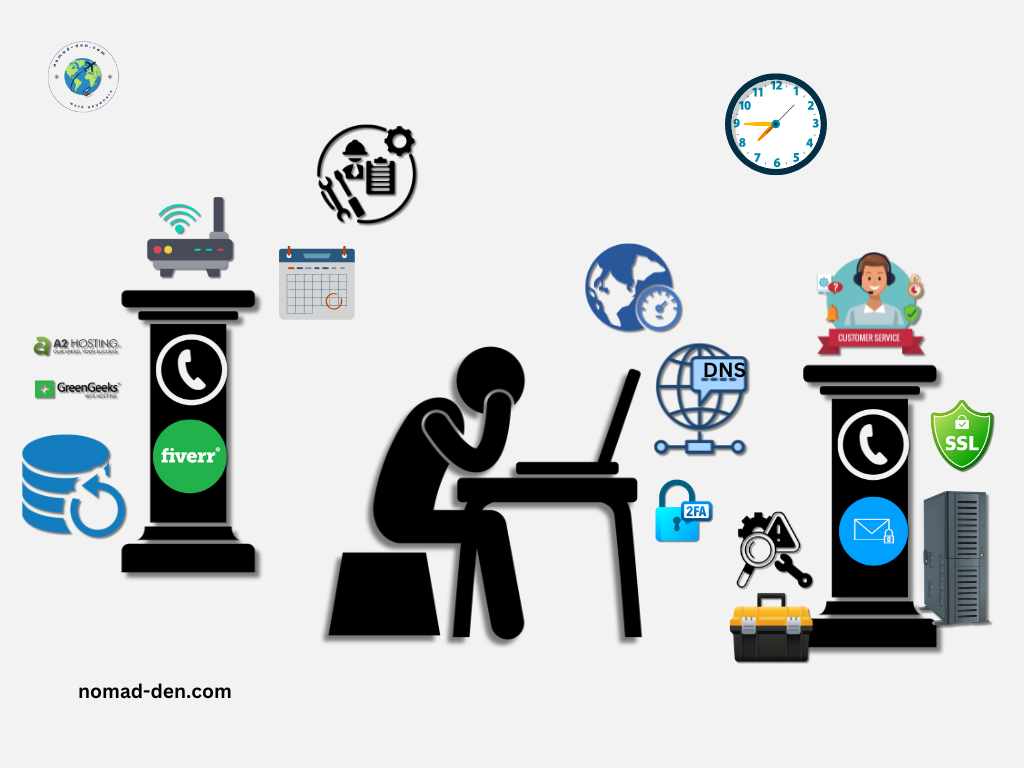
Troubleshooting & Maintenance
Even after your systems are set up, regular maintenance and troubleshooting are key to keeping your online business running smoothly. Technical issues can crop up unexpectedly, whether it’s a sudden drop in website speed or an email campaign not functioning properly. Staying proactive and knowing how to handle these issues can save you time and prevent bigger problems down the line.
Tips for Ongoing Maintenance:
- Regular Backups: Ensure your website and customer data are regularly backed up. This protects your business from data loss and allows you to restore your site quickly if needed.
- Monitor Website Performance: Keep an eye on your website’s performance using tools like Google Analytics or speed testing services. This helps you spot any slowdowns or performance issues early on.
- Security Updates: Regularly update your plugins, themes, and any software you’re using. Outdated software can introduce security vulnerabilities.
Reliable Hosting for Support:
When technical issues arise, having a reliable hosting provider with strong customer support can make all the difference. Hosting.com (formerly known as A2 Hosting) has an excellent track record, with response times typically measured in seconds, 24/7/365. Their support team resolves most tickets in under two hours, no matter what time of day it is. With a satisfaction rate above 90%, Hosting.com ensures you won’t be left stuck dealing with complex technical issues on your own.
You can read my full breakdown of Hosting.com’s features and performance in this post before exploring their plans below.
Conclusion
Every online business runs into technical hurdles. The difference between feeling stuck and moving forward is how you respond to them. By leaning on reliable hosting, taking time to understand the essentials, and outsourcing when needed, you can turn tech challenges into opportunities to strengthen your systems.
The more you build this mindset, the more confidence you’ll have tackling whatever comes next — whether it’s launching new tools, expanding your audience, or scaling your business. Technical roadblocks aren’t the end of the journey; they’re just part of the path forward.
Continue Reading Related Posts
- Build an Online Business and Escape the 9–5 – Learn step-by-step strategies to start and grow your own online business, from choosing tools to building long-term systems for financial freedom.
- Systeme for Your System: The Budget Business Builder – Explore how Systeme.io simplifies funnels, email marketing, and CRM in one affordable platform, making it easier to launch and scale your business on a budget.
- Best Tools for Online Privacy and Security – Protect your online business with essential cybersecurity tools — from VPNs to password managers — to safeguard your data and stay secure while working online.
FAQ:
How do I know when to outsource technical tasks?
If a task is taking too much time, is outside your expertise, or is causing frustration, it’s a good time to outsource to a professional.
What should I prioritize first: DNS setup or SSL installation?
Both are important, but DNS setup usually comes first as it ensures your domain points to the right server. SSL can be set up afterward for added security.
Do I need coding skills to manage technical tasks for my website?
Not at all. Most modern platforms are built with drag-and-drop editors, making it easy to manage your website without touching code.







